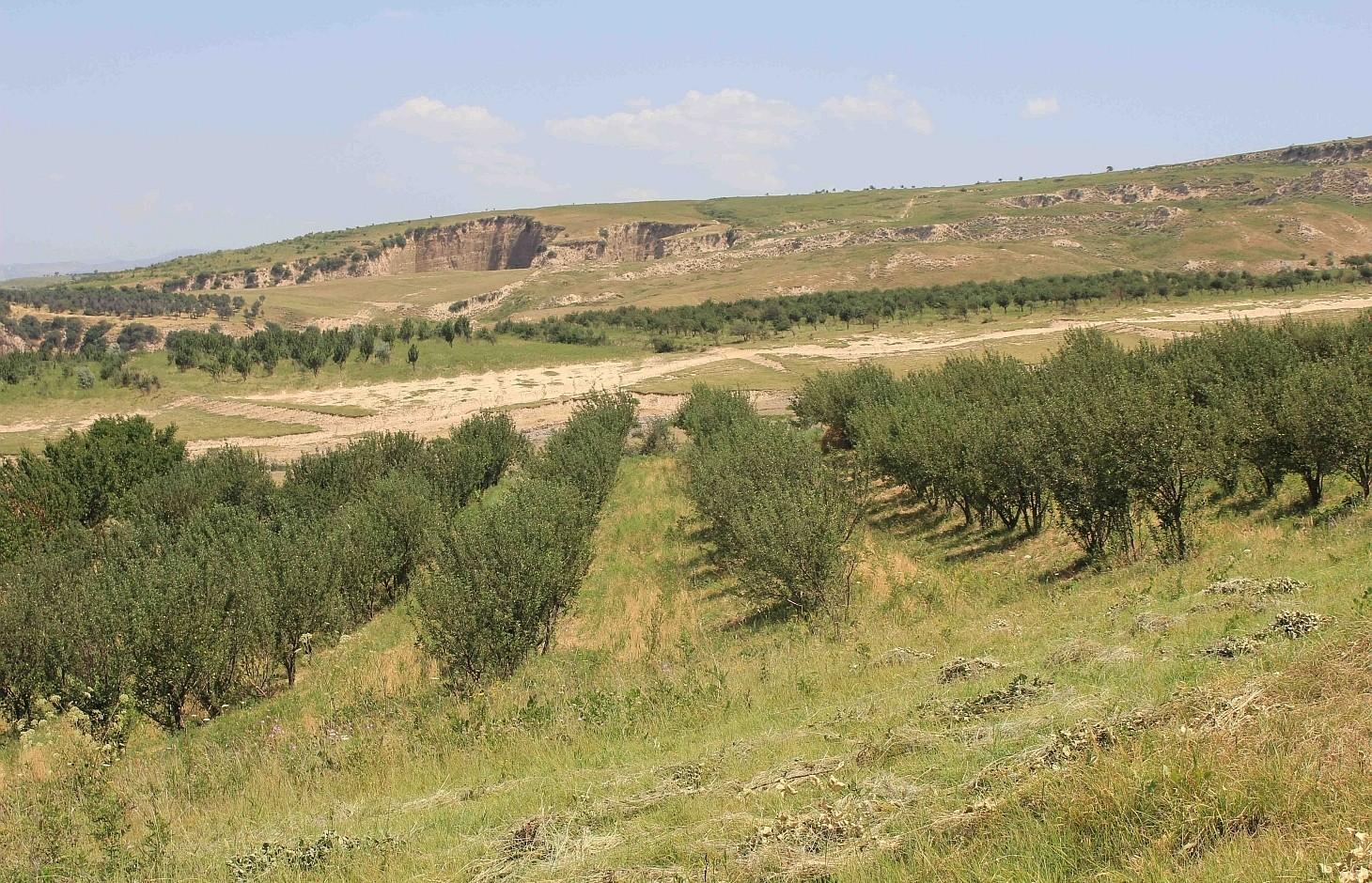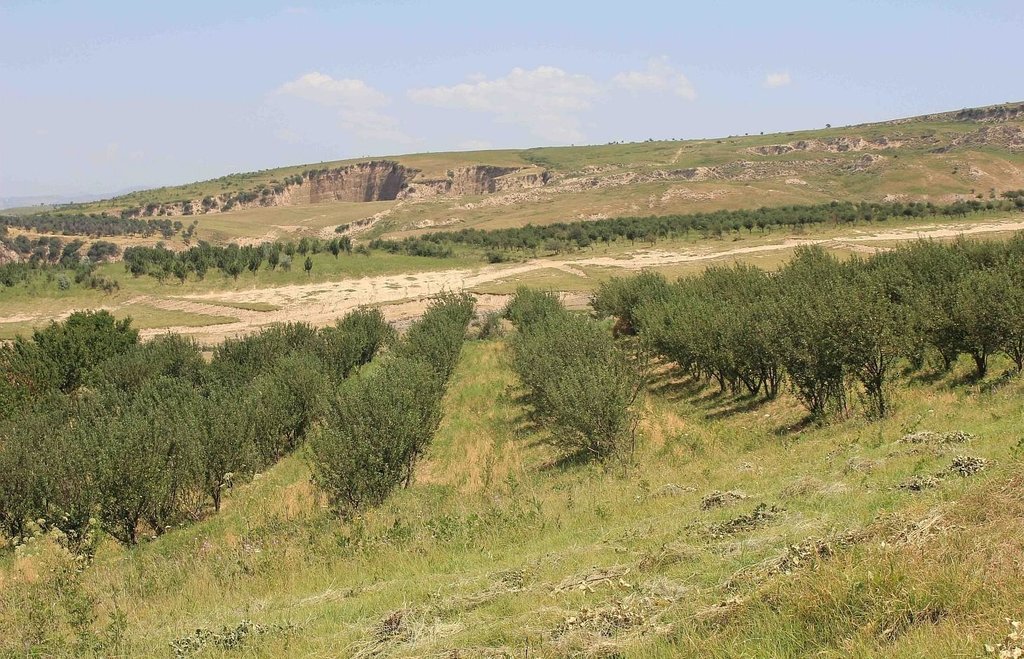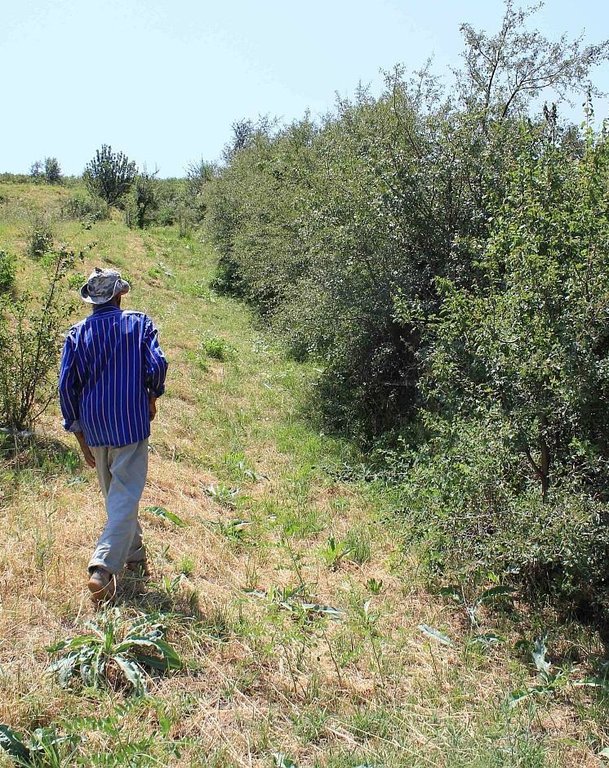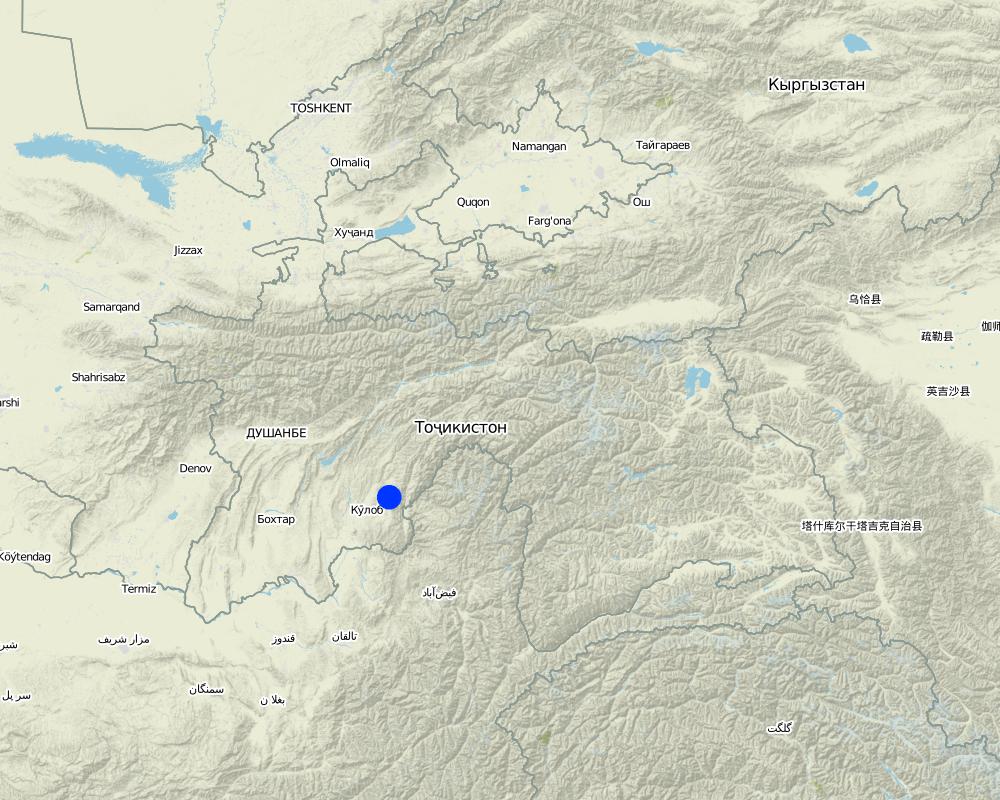Mixed fruit tree orchard with intercropping of Esparcet and annual crops in Muminabad District [Tayikistán]
- Creación:
- Actualización:
- Compilador: Malgorzata Conder
- Editor: –
- Revisores: Laura Ebneter, Alexandra Gavilano, Fabian Ottiger
Bog
technologies_1128 - Tayikistán
- Resumen completo en PDF
- Resumen completo en PDF para imprimir
- Resumen completo en el navegador
- Resumen completo (sin formato)
- Mixed fruit tree orchard with intercropping of Esparcet and annual crops in Muminabad District: 28 de diciembre de 2016 (inactive)
- Mixed fruit tree orchard with intercropping of Esparcet and annual crops in Muminabad District: 31 de mayo de 2017 (inactive)
- Mixed fruit tree orchard with intercropping of Esparcet and annual crops in Muminabad District: 2 de junio de 2017 (inactive)
- Mixed fruit tree orchard with intercropping of Esparcet and annual crops in Muminabad District: 4 de agosto de 2019 (public)
Visualizar secciones
Expandir todo Colapsar todos1. Información general
1.2 Detalles de contacto de las personas de referencia e instituciones involucradas en la evaluación y la documentación de la Tecnología
Especialista MST:
Nombre de la(s) institución(es) que facilitaron la documentación/ evaluación de la Tecnología (si fuera relevante)
NCCR North-South (NCCR North-South) - KirguistánNombre de la(s) institución(es) que facilitaron la documentación/ evaluación de la Tecnología (si fuera relevante)
CARITAS (Switzerland) - Suiza1.3 Condiciones referidas al uso de datos documentados mediante WOCAT
El compilador y la/s persona(s) de referencia claves aceptan las condiciones acerca del uso de los datos documentados mediante WOCAT:
Sí
2. Descripción de la Tecnología MST
2.1 Breve descripción de la Tecnología
Definición de la Tecnología:
Orchard based agroforestry established on the hill slopes of Muminabad
2.2 Descripción detallada de la Tecnología
Descripción:
Between 1993 and 94 an individual farmer initiated an orchard by planting a mix of fruit trees, such as apricots, walnuts, cherries, almonds and mostly apple trees in the rainfed hill zones of Muminabad District.
In the first couple of years 416 newly planted seedlings were watered manually: water was brought by trucks near to the plot and distributed to the seedlings with buckets. The orchard was established on the existing grazing land and therefore the seedlings had to be secured with a fence from livestock grazing nearby. First hard wire was used for fencing. Simultaneously, hawthorns (Dulona in Tajik) were planted along the fence in order to provide even stronger protection and establish a live fence for the future. Now, the fruit trees are fully-grown and fruits can be harvested every year. The farmer prunes trees annually, which is the key for fruit production. The farmer pointed out that in rainfed areas soils contain less nutrients and usually big trees do not produce high yield. Furthermore, pruned tree branches are used as firewood. The farmer also applies the pesticides B52 and B58, three times a year in the months of April, May and June. The total area of the plot is 1.03 hectares, whereof 0.60 hectares are orchard; Esparcet is covering roughly 0.30 hectares, 0.07 hectare is for haymaking and the rest of the 0.06 hectares is used for growing chickpea and wheat. There is also a road for machinery to pass and to turn around when plowing the land.
Purpose of the Technology: Shortly after the fall of the Soviet Union, the government officials distributed land to the villagers. The farmer always had a big interest to establish a small orchard and he obtained little more than a hectare of land. It is his project for retirement. He and his family worked hard throughout the establishment phase. They experimented by planting a variety of vegetables including melons and watermelons. The wild animals ate many of the vegetables and melons, what resulted in the farmer's idea of intercropping Esparcet.
Establishment / maintenance activities and inputs: According to the farmer, the first two years were very labor intensive and crucial to establish the orchard. He also had to face a challenge posed by the community, as overnight people from the nearby villages stole roughly 100 of his newly planted seedlings. This is one of the reasons why the farmer had to plant hawthorn in order to establish a live fence. In summary: The establishment phase included planting of young seedlings; manually watering for the first two years; plowing in between the tree rows by machinery; building a fence around the plot and planting/sowing hawthorns. Maintenance activities consist of the following activities: planting new seedlings; pruning of existing trees; grafting new sorts of trees, plowing by tractor in between the tree rows annually; chickpea and wheat cultivation; application of chemical pesticides three times a year. For cutting wheat, the farmer gets support from his son and friends. Every day, he goes to his orchard, which is located at a distance of more than 1.5km from his house. When this technology was documented he was about to build a small clay hut in his orchard.
It should be noted that the terrace structure was not implemented at once, but over the years tilling in between the tree rows along the contour lines formed terrace shaped rows.
The structure of terraces has been built over the years by tilling in between tree rows along the contour lines.
Natural / human environment: Muminabad is situated in the southwest of Tajikistan (Khatlon Province) and its hills are covered by loessial soil. Winter temperatures are low and the amount of precipitation is high. Summers are very hot and dry. The growing season lasts from March/ April to September/ October.
2.3 Fotografías de la Tecnología
2.5 País/ región/ lugares donde la Tecnología fue aplicada y que se hallan comprendidos por esta evaluación
País:
Tayikistán
Región/ Estado/ Provincia:
Khatlon, Tajikistan
Especifique más el lugar :
Muminabad
Comentarios:
Total area covered by the SLM Technology is 0.01 km2.
1.03 ha in total, whereof 0.6 ha is orchard
Map
×2.6 Fecha de la implementación
Si no se conoce el año preciso, indique la fecha aproximada:
- 10-50 años atrás
2.7 Introducción de la Tecnología
Especifique cómo se introdujo la Tecnología:
- mediante la innovación de usuarios de tierras
3. Clasificación de la Tecnología MST
3.2 Tipo(s) actuales de uso de la tierra donde se aplica la Tecnología
Mezcla de tipos de uso de tierras dentro de la misma unidad de tierras: :
Sí
Especifique el uso combinado de tierras (cultivos/ pastoreo/ árboles):
- Agroforestería

Tierras cultivadas
- Cosecha de árboles y arbustos
Cultivos de matorrales y arbustos - Especifique cultivos:
- frutas de pepita (manzanas, peras, membrillo, etc.)
- frutas de hueso (durazno, albaricoque, cerezos, ciruelas, etc)
Número de temporadas de cultivo por año:
- 1
Especifique:
Longest growing period in days: 180Longest growing period from month to month: April-Sept/oct
¿Se practica el intercultivo?
Sí
Si respondió que sí, especifique qué cultivos son intercultivados:
wheat, chickpeas

Tierra de pastoreo
Pastoreo extenso:
- Pastoralismo semi-nómada

Bosques
Comentarios:
Major land use problems (compiler’s opinion): Soil erosion by water, heavy rainfalls, absence of vegetative cover on the hill slopes.
Major land use problems (land users’ perception): Soil erosion by water, extensive grazing, gully erosion.
3.4 Provisión de agua
Provisión de agua para la tierra donde se aplica la Tecnología:
- mixta de secano – irrigada
3.6 Medidas MST que componen la Tecnología

medidas vegetativas
- V1: Cubierta de árboles y arbustos

medidas de manejo
- M2: Cambio de gestión/ nivel de intensidad
Comentarios:
Type of vegetative measures: aligned: -contour
3.7 Principales tipos de degradación de la tierra encarados con la Tecnología

erosión de suelos por agua
- Wt: pérdida de capa arable/ erosión de la superficie
- Wg: erosión en cárcavas
Comentarios:
Main causes of degradation: soil management (Extensive grazing led to a reduction of soil cover, which is the major source of erosion), deforestation / removal of natural vegetation (incl. forest fires) (Removal of trees left the soil unprotected against precipitation and extreme weather events), over-exploitation of vegetation for domestic use (Trees were cut as firewood for fuel consumption), overgrazing, land tenure (Land abandonment after Soviet collapse), governance / institutional (Lacking istitutional support)
Secondary causes of degradation: Heavy / extreme rainfall (intensity/amounts) (More extreme rainfall events), floods (As a result of extreme events there are more floods in the region)
3.8 Prevención, reducción o restauración de la degradación de la tierra
Especifique la meta de la Tecnología con relación a la degradación de la tierra:
- prevenir la degradación de la tierra
- reducir la degradación de la tierra
Comentarios:
Main goals: prevention of land degradation, mitigation / reduction of land degradation
Secondary goals: rehabilitation / reclamation of denuded land
4. Especificaciones técnicas, actividades de implementación, insumos y costos
4.1 Dibujo técnico de la Tecnología
Especificaciones técnicas (relacionadas al dibujo técnico):
The fenced plot is mainly used for the orchard intercropped with chickpea, flax and wheat. Esparcet and grass for haymaking covers only a small part of the plot. The part on the left handside is also used to turn the tractor when ploughing, which is why this part is affected by soil erosion and rills. The whole property is fenced by hawthorns (dulona). The orchard has a terrace-like structure due to annual plowing by tractor.
Location: Sarmaydon 2. Muminabad
Technical knowledge required for field staff / advisors: moderate
Technical knowledge required for land users: moderate
Main technical functions: control of raindrop splash, control of dispersed runoff: retain / trap, control of dispersed runoff: impede / retard, improvement of ground cover, water harvesting / increase water supply, increase of biomass (quantity)
Secondary technical functions: improvement of surface structure (crusting, sealing), improvement of topsoil structure (compaction), increase in organic matter, increase / maintain water stored in soil, reduction in wind speed
Aligned: -contour
Number of plants per (ha): 416
Vertical interval between rows / strips / blocks (m): 3
Vertical interval within rows / strips / blocks (m): 3.5
Fruit trees / shrubs species: apple, apricot, pear, cherry
Other species: intercropped with chickpea and wheat
Autor:
Q. Shokirov
Fecha:
12-07-2012
4.2 Información general sobre el cálculo de insumos y costos
otra / moneda nacional (especifique):
Somoni
Si fuera relevante, indique la tasa de cambio de dólares americanos a la moneda local (ej. 1 U$ = 79.9 Reales Brasileros): 1 U$ =:
4,83
Indique el costo promedio del salario de trabajo contratado por día:
12.40
4.3 Actividades de establecimiento
| Actividad | Momento (estación) | |
|---|---|---|
| 1. | Digging a deep barrier for protection around the plot with a bulldozer, 1 day | once (1993) |
| 2. | Plowing in between the rows by tractor, labor, petrol and rent for one day | once (1993) |
| 3. | Planting fruit trees, 3 days by 3 persons (3-5 Somoni per seedling, 3 Som/ seedling planting) | once (1993) |
| 4. | Watering young seedlings for the first couple of years by truck (60 TJS per truck) | one day a week/ 50 times a year |
| 5. | Construction of fence with hard wire and haw thorn (approx. 320m) | once |
| 6. | Buying and replanting of 100 stolen fruit seedlings | once |
4.4 Costos e insumos necesarios para el establecimiento
| Especifique insumo | Unidad | Cantidad | Costos por unidad | Costos totales por insumo | % de los costos cubiertos por los usuarios de las tierras | |
|---|---|---|---|---|---|---|
| Mano de obra | Labour | ha | 1,0 | 4629,333 | 4629,33 | 100,0 |
| Equipo | Machine use | ha | 1,0 | 227,833 | 227,83 | 100,0 |
| Equipo | Petrol | l | 20,0 | 1,14 | 22,8 | 100,0 |
| Material para plantas | Seedlings | Pieces | 516,0 | 0,621 | 320,44 | 100,0 |
| Material de construcción | Hard wire and pillars | m | 320,0 | 1,4556 | 465,79 | 100,0 |
| Costos totales para establecer la Tecnología | 5666,19 | |||||
| Costos totales para establecer la Tecnología en USD | 1173,12 | |||||
Comentarios:
Duration of establishment phase: 24 month(s)
4.5 Actividades de establecimiento/ recurrentes
| Actividad | Momento/ frequencia | |
|---|---|---|
| 1. | Tractor ploughing, labor, petrol and rent, 1-2 hours, 2 persons | spring, once a year |
| 2. | Soil loosening around trees, 5-6 days, 3-4 persons | spring, once a year |
| 3. | Pruning of the approx. 400 fruit trees (3 TJS per tree) | every year |
| 4. | Bringing water from village and watering (40 liters a day,20l on each donkey, 3 h for walking and watering) | every day |
| 5. | Applying pesticides, 1 person, 7 days (5 hours per day) | Three times a year: April, May, June |
| 6. | Sowing wheat and chickpea (1 person, 2 hours) | spring, once a year |
| 7. | Cutting wheat and chickpea (2 persons, 4 hours) | autumn, once |
| 8. | Harvesting fruit trees (3.6 TJS per fruit tree) | autumn, once a year |
4.6 Costos e insumos necesarios para actividades de mantenimiento/ recurrentes (por año)
| Especifique insumo | Unidad | Cantidad | Costos por unidad | Costos totales por insumo | % de los costos cubiertos por los usuarios de las tierras | |
|---|---|---|---|---|---|---|
| Mano de obra | Labour | ha | 1,0 | 4493,5 | 4493,5 | 100,0 |
| Equipo | Machine use | ha | 1,0 | 10,3 | 10,3 | 100,0 |
| Equipo | Petrol | l | 20,0 | 1,14 | 22,8 | 100,0 |
| Material para plantas | Pesticides | kg | 0,25 | 186,0 | 46,5 | 100,0 |
| Material para plantas | Seeds | pc | 1,0 | 3,7 | 3,7 | 100,0 |
| Indique los costos totales para mantenecer la Tecnología | 4576,8 | |||||
| Costos totales para mantener la Tecnología en USD | 947,58 | |||||
4.7 Factores más determinantes que afectan los costos:
Describa los factores más determinantes que afectan los costos:
The technology was established during the Soviet Union and most of the expenses were calculated on the price basis of that time. If technology is priced by current prices, the total sum would be very high and no farmer would be able to afford. Thus, current prices were not identified. Nowadays, machinery cost, buying hard wire for fencing and buying seedlings would be the most costly factors.
5. Entorno natural y humano
5.1 Clima
Lluvia anual
- < 250 mm
- 251-500 mm
- 501-750 mm
- 751-1,000 mm
- 1,001-1,500 mm
- 1,501-2,000 mm
- 2,001-3,000 mm
- 3,001-4,000 mm
- > 4,000 mm
Zona agroclimática
- Sub-húmeda
Thermal climate class: temperate
5.2 Topografía
Pendientes en promedio:
- plana (0-2 %)
- ligera (3-5%)
- moderada (6-10%)
- ondulada (11-15%)
- accidentada (16-30%)
- empinada (31-60%)
- muy empinada (>60%)
Formaciones telúricas:
- meseta/ planicies
- cordilleras
- laderas montañosas
- laderas de cerro
- pies de monte
- fondo del valle
Zona altitudinal:
- 0-100 m s.n.m.
- 101-500 m s.n.m.
- 501-1,000 m s.n.m
- 1,001-1,500 m s.n.m
- 1,501-2,000 m s.n.m
- 2,001-2,500 m s.n.m
- 2,501-3,000 m s.n.m
- 3,001-4,000 m s.n.m
- > 4,000 m s.n.m
5.3 Suelos
Profundidad promedio del suelo:
- muy superficial (0-20 cm)
- superficial (21-50 cm)
- moderadamente profunda (51-80 cm)
- profunda (81-120 cm)
- muy profunda (>120 cm)
Textura del suelo (capa arable):
- áspera/ ligera (arenosa)
Materia orgánica de capa arable:
- media (1-3%)
5.4 Disponibilidad y calidad de agua
Agua subterránea:
> 50 m
Disponibilidad de aguas superficiales:
pobre/ ninguna
Calidad de agua (sin tratar):
inutilizable
5.5 Biodiversidad
Diversidad de especies:
- mediana
5.6 Las características de los usuarios de la tierra que aplican la Tecnología
Orientación del mercado del sistema de producción:
- subsistencia (autoprovisionamiento)
Ingresos no agrarios:
- 10-50% de todo el ingreso
Nivel relativo de riqueza:
- promedio
Individuos o grupos:
- individual/ doméstico
Nivel de mecanización:
- trabajo manual
- mecanizado/motorizado
Género:
- mujeres
- hombres
Indique otras características relevantes de los usuarios de las tierras:
Population density: 100-200 persons/km2
Annual population growth: 1% - 2%
40% of the land users are average wealthy.
5.7 Área promedio de la tierra usada por usuarios de tierra que aplican la Tecnología
- < 0.5 ha
- 0.5-1 ha
- 1-2 ha
- 2-5 ha
- 5-15 ha
- 15-50 ha
- 50-100 ha
- 100-500 ha
- 500-1,000 ha
- 1,000-10,000 ha
- > 10,000 ha
¿Esto se considera de pequeña, mediana o gran escala (refiriéndose al contexto local)?
- pequeña escala
5.8 Tenencia de tierra, uso de tierra y derechos de uso de agua
Tenencia de tierra:
- estado
Derechos de uso de tierra:
- arrendamiento
Comentarios:
Land ownership is based on the land user certificate conferred by the government.
5.9 Acceso a servicios e infraestructura
salud:
- pobre
- moderado
- bueno
educación:
- pobre
- moderado
- bueno
asistencia técnica:
- pobre
- moderado
- bueno
empleo (ej. fuera de la granja):
- pobre
- moderado
- bueno
mercados:
- pobre
- moderado
- bueno
energía:
- pobre
- moderado
- bueno
caminos y transporte:
- pobre
- moderado
- bueno
agua potable y saneamiento:
- pobre
- moderado
- bueno
servicios financieros:
- pobre
- moderado
- bueno
6. Impactos y comentarios para concluir
6.1 Impactos in situ demostrados por la Tecnología
Impactos socioeconómicos
Producción
producción de cultivo
producción de forraje
calidad de forraje
producción de madera
área de producción
Disponibilidad y calidad de agua
demanda de agua para irrigar
Ingreso y costos
gastos en insumos agrícolas
ingreso agrario
diversidad de fuentes de ingreso
carga de trabajo
Impactos socioculturales
seguridad alimentaria/ autosuficiencia
oportunidades recreativas
mitigación de conflicto
Impactos ecológicos
Ciclo de agua/ escurrimiento de sedimento
escurrimiento superficial
evaporación
Suelo
humedad del suelo
cubierta del suelo
pérdida de suelo
encostramiento/ sellado de suelo
compactación de suelo
materia orgánica debajo del suelo C
Biodiversidad: vegetación, animales
biomasa/ sobre suelo C
diversidad de hábitats
6.2 Impactos fuera del sitio demostrados por la Tecnología
inundaciones río abajo
capacidad de amortiguación/ filtrado
6.3 Exposición y sensibilidad de la Tecnología al cambio climático gradual y a extremos relacionados al clima/ desastres (desde la percepción de los usuarios de tierras)
Cambio climático gradual
Cambio climático gradual
| Estación | Incremento o reducción | ¿Cómo es que la tecnología soporta esto? | |
|---|---|---|---|
| temperatura anual | incrementó | no muy bien |
Extremos (desastres) relacionados al clima
Desastres climatológicos:
| ¿Cómo es que la tecnología soporta esto? | |
|---|---|
| tormenta de lluvia local | bien |
| tormenta de viento | bien |
Desastres climatológicos
| ¿Cómo es que la tecnología soporta esto? | |
|---|---|
| sequía | no muy bien |
Desastres hidrológicos
| ¿Cómo es que la tecnología soporta esto? | |
|---|---|
| inundación general (río) | no muy bien |
6.4 Análisis costo-beneficio
¿Cómo se comparan los beneficios con los costos de establecimiento (desde la perspectiva de los usuarios de tierra)?
Ingresos a corto plazo:
neutral/ balanceado
Ingresos a largo plazo:
muy positivo
¿Cómo se comparan los beneficios con los costos de mantenimiento/ recurrentes (desde la perspectiva de los usuarios de tierra)?
Ingresos a corto plazo:
neutral/ balanceado
Ingresos a largo plazo:
muy positivo
Comentarios:
After 6 years income is very comparable to the establishment cost
6.5 Adopción de la Tecnología
Comentarios:
98% of land user families have adopted the Technology with external material support
2% of land user families have adopted the Technology without any external material support
5 land user families have adopted the Technology without any external material support
There is a little trend towards spontaneous adoption of the Technology
Comments on adoption trend: Cost of the technology is very expensive, which discourages farmers to implement orchards based agroforestry.
6.7 Fuerzas/ ventajas/ oportunidades de la Tecnología
| Fuerzas/ ventajas/ oportunidades desde la perspectiva del usuario de la tierra |
|---|
|
Grafting trees especially apple and pear trees on native hawthorns is an affordable and sustainable way of creating orchards in semi-arid areas with rainfed agriculture. Hawthorn is a plant adjusted to dry areas with strong and deep roots, which endures the hot summer months. How can they be sustained / enhanced? Tree nursery workshops and educational programmes about local species through seed associations |
|
Intercropping wheat, chickpea, flax and Esparcet in between the tree rows gives an extra economic incentive and also improves land productivity. How can they be sustained / enhanced? Knowledge raising, inspection of those good practices by other farmers |
| Haymaking with natural grass and Esparcet provide the farmer with an opportunity to produce hay for the winter months for his livestock, so that he does not need to purchase it from the market at high costs. |
| The farmer practices pruning on a regular basis to keep the trees in good shape for better fruit production, but also to have sufficient fire wood for the winter months. |
| Fuerzas/ ventajas/ oportunidades desde la perspectiva del compilador o de otra persona de referencia clave |
|---|
|
Compared to other plots with orchards there is almost no soil erosion which is mainly due to good land management practices, e.g. the slow building up of terraces. How can they be sustained / enhanced? Sustain the practice of contour ploughing |
6.8 Debilidades/ desventajas/ riesgos de la Tecnología y formas de sobreponerse a ellos
| Debilidades/ desventajas/ riesgos desde la perspectiva del usuario de la tierra | ¿Cómo sobreponerse a ellas? |
|---|---|
| It is expensive to establish such orchards nowadays, because of the high cost for purchasing seedlings and hiring other machinery. | See comment below |
| Growing new seedlings and grafting trees is a cheaper way of establishing a new orchard, but it is not commonly practiced among the farmers in the region. | There should be a tree nursery workshop in order to raise awareness among the young generation of farmers. |
| Debilidades/ desventajas/ riesgos desde la perspectiva del compilador o de otra persona de referencia clave | ¿Cómo sobreponerse a ellas? |
|---|---|
| Since the orchard is located in a rainfed area, hot summer months make the technology vulnerable to drought. To some extent the technology is tolerant to dryer summers, but maybe not for prolonged droughts (e.g. two successive drought). |
The farmer has suggested that grafting fruit trees on native hawthorn (dulona) trees has potential for farmers when establishing orchards in rainfed areas. In extreme events (extremely dry years), the farmer brings water for supplementary irrigation from his house by donkey. |
7. Referencias y vínculos
7.1 Métodos/ fuentes de información
Vínculos y módulos
Expandir todo Colapsar todosVínculos
No hay vínculos
Módulos
No se hallaron módulos





